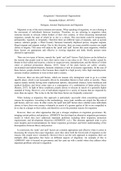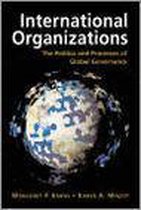Assignment 5 International Organizations
Samantha Nijboer- 2078352
Refugees, Internal Displacement and Migration
Migration is one of the most common movements. When speaking of migration, we are referring to
the movement of individuals between locations. Therefore, we are referring to migration when
someone decides to relocate within borders of their own country, or when discussing international
migration, outside the state of which he or she is a citizen. This movement could be temporarily,
permanently, regularly or irregularly. Therefore there are different types of migrants, such as asylum
seekers, stateless people, a Third Country National, Internally displaced person, irregular migrant,
illegal migrant and migrant worker. Due to this diversity, there are many possible reasons one might
choose to migrate. This essay will analyze the ‘push’ and ‘pull’ factors that cause migration, whether
these factors are appropriate and effective in viewing migration and lastly briefly present some
alternative approaches.
There are two types of factors, namely the ‘push’ and ‘pull’ factors. Push factors can be defined as
the reasons that people want to leave their native state to any place at all. This is mostly caused by
threats to their safety and security, a desire to escape poverty, unemployment, and the threat of violent
crime or political persecution (Ramos, 2017). Some of the push factors are safety/ security,
environment and natural disasters, domestic situations or lack of economic opportunity. In the case of
these factors, people decide to flee because there might be a high poverty ratio, high unemployment,
extreme weather conditions or wars in their native country.
However, there are also pull factors, which are reasons why immigrants want to go to a certain
specific place, which is not necessarily driven by immediate threats to their safety or security. These
aspects mainly include having more employment options, educational chances, better healthcare and
medical facilities, and lower crime rates as a consequence of a combination of better police forces
(Ramos, 2017). In light of these conditions, people choose to relocate in search of a generally higher
standard of living. However, a lot of individuals migrate for a variety of reasons that are impacted by
more than one aspect. This is due to the fact that those factors are frequently connected.
When looking at migration, this approach is particularly successful when considering potential
reasons for migration. According to this methodology, many push variables are simply the flip side of
pull factors, and vice versa. In other words, the 'push' and 'pull' factors show whether some individuals
choose to leave their own country voluntarily in search of a greater quality of life or are compelled to
do so due to a danger to their safety, and therefore covers the potential reasons for migration.
However, there are other approaches that put a stronger emphasis on migration governance. By
merging current policies and practices, ADMIGOV has developed an alternative migration governance
model in which they have addressed important problems including labor migration, protection
requirements, and development objectives (ADMIGOV, n.d.). This alternate approach aims to give
more insights and recommendations for future migration governance and better understanding of the
discrepancies between theory and practice.
In conclusion, the ‘push’ and ‘pull’ factors are certainly appropriate and effective when it comes to
discussing the reasons that cause migration, since they show both the forced side of migration as the
reasons why people move voluntarily. However this is not the only approach to migration, there are
multiple other approaches that focus on different aspects of migration. An example of this is
ADMIGOV who is focused on governance and has came up with a model where they address other
important problems relevant to migration.





